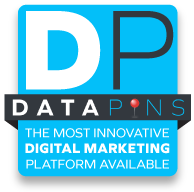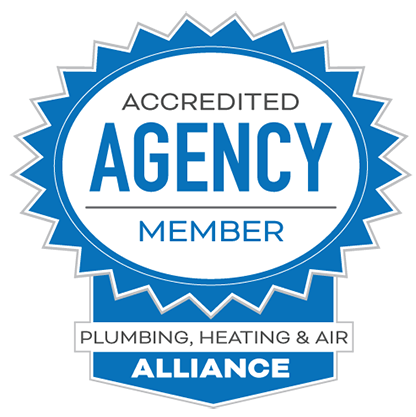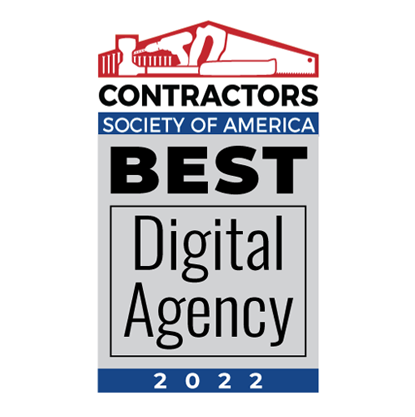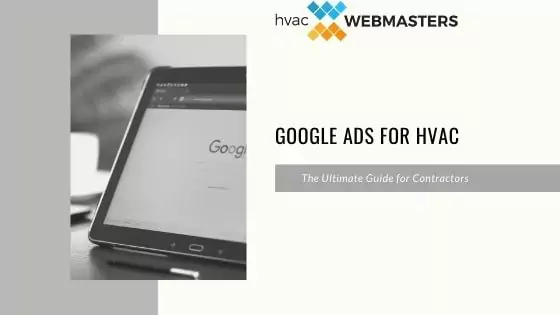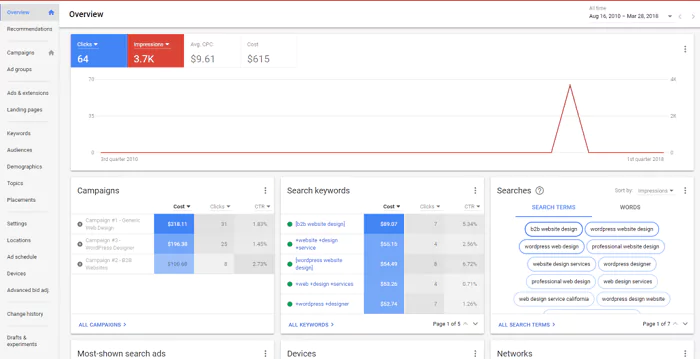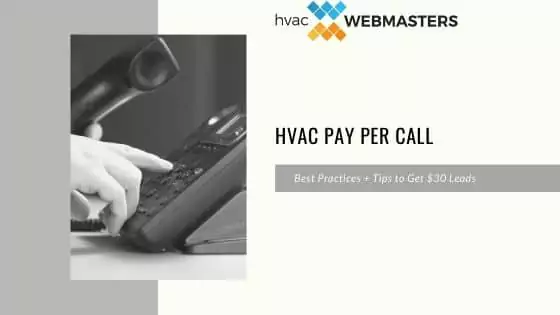HVAC PPC campaigns are an obvious way to expose potential customers to your company and services, especially during the peak winter and summer seasons.
PPC Ads sound great. They ensure your company appears above organic search results for a litany of HVAC keywords that historically drive business to local contractors.
But where do you start as a local heating and cooling contractor investing in pay-per-click in 2025? And what challenges will inevitably arise?
As the founder of HVAC Webmasters, I’ve been helping local companies like yours generate qualified leads online for 15+ years.
The following guide outlines the keys to HVAC PPC success, including how to generate high-quality leads and boost ROI.
Key Takeaway
PPC for HVAC companies works best as part of a broader strategic marketing campaign.
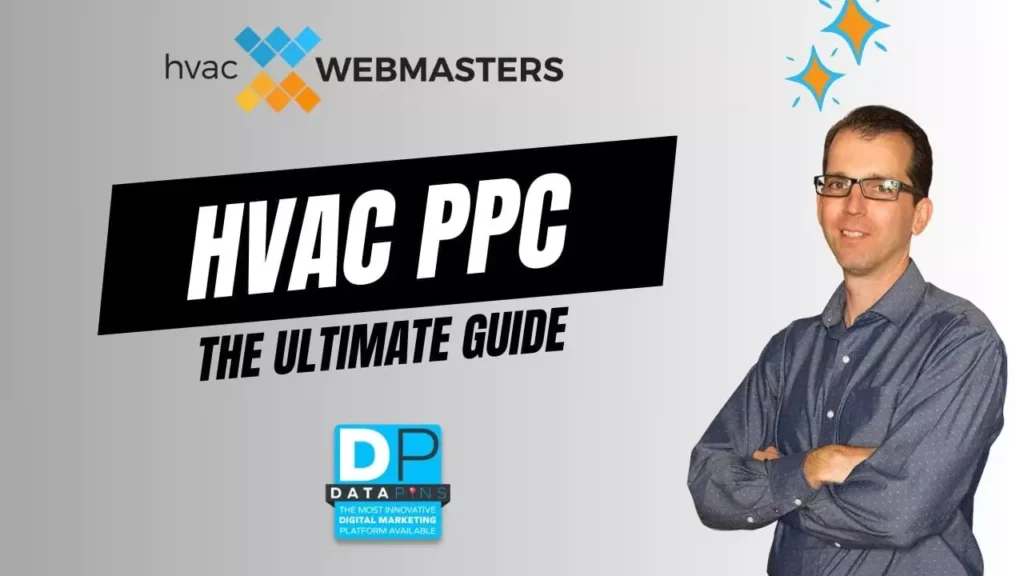
What is HVAC PPC?
PPC, or pay-per-click, is a digital advertising model that empowers local HVAC companies to promote their services and/or products through clickable ads.
Advertisers bid on a click’s monetary value (via platforms like Google) and are charged a fee each time a user clicks through their advertisement.
Types of HVAC PPC Ads & When to Use Each
Google offers a range of PPC ad formats, each with unique benefits and drawbacks. Below, I’ll outline the specific ad types and explain how your HVAC company can take advantage of each.
Search Ads
Search ads emulate a standard SEO result and include a URL on your landing page. Search Ads may appear above organic results and toward the bottom of the search engine results page (SERP).
While search ads are intended to resemble traditional organic search results, they do include the word “Ad” to notify searchers that they are not, in fact, organic results.
When to Use: You are a newer HVAC company without many reviews or organic rankings.
Display Ads
Display ads combine text and images and appear throughout Google’s display network, reaching people “where they are” as they browse the web.
Examples of areas in which display ads appear include Google-owned platforms like YouTube and Gmail.
When to Use: You are somewhat established and ready to start growing your consumer base.
Local Service Ads
Local Service Ads, or LSAs, are technically outside the scope of PPC because they utilize a pay-per-lead model.
However, HVAC companies often view LSA through the lens of pay-per-click advertising and appreciate its added emphasis on local consumers.
Consumers tend to trust Local Service Ads more than search or display ads because the listed businesses have been screened, and searchers can quickly view their Google reviews alongside the ad.
When to Use: You’ve accumulated a substantial number of Google reviews and are looking to generate more leads efficiently.
Retargeting Ads
Retargeting or remarketing ads utilize browser cookies to reengage with previous website visitors on other platforms, such as Google, Facebook, Instagram, YouTube, and TikTok.
These ad types tend to convert at a higher rate than others because the prospect has already demonstrated some level of interest in your services, making them a warm lead rather than a cold one.
When to Use: Your website receives a significant amount of relevant monthly traffic based on your Google Analytics and Google Search Console data.
Video Ads
HVAC companies can incorporate video ads into their PPC strategy using YouTube’s various video ad options, which are:
- Skippable In-Stream Ads
- Non-Skippable In-Stream Ads
- In-Feed Ads
- Outstream Ads
- Masthead Ad
If you’ve ever browsed YouTube (which most of you have), you’ve probably seen each of these ad types on your screen.
For video ads to produce a positive ROI, they must quickly identify a consumer pain point and provide an appealing solution.
When to Use: As an owner (or your staff), you have the ability and savvy to capture appealing video content for your business.
Paid Social Media Ads
Paid social media ads often involve video ads (as noted above) but expand beyond YouTube to Facebook, Instagram, TikTok, and other platforms.
While video ads have emerged as the most popular form of social advertising, platforms also allow ads with still images.
Since Meta owns both Facebook and Instagram, HVAC companies can advertise on both platforms through a single Meta Ads account.
When to Use: Your company has established a digital presence on Google and multiple review sites and wants to expand to reach more users.
Setting Up a High-Converting HVAC PPC Campaign
A profitable HVAC PPC campaign requires a strong foundation of goal setting and a complementary marketing strategy.
After establishing that foundation, understanding the nuances of keyword research, budgeting, and landing page optimization will dictate your ultimate success or failure.
Goals and Budgeting
What are your PPC goals, and how will you maneuver your budget to reach them? Start by selecting one of the following goals:
- Awareness
- Website Traffic
- Lead Generation
- Sales
- Retargeting
Once you identify your primary goal, set a budget for how much you are willing to spend per click, day, month, and campaign.
A monthly HVAC PPC budget typically ranges from $100 to $5,000, but it varies significantly based on your specific financial benchmarks.
Keyword Research
While keyword research is essential to SEO success, it’s even more influential on the quality of your PPC campaign. Effective HVAC PPC campaigns target high-conversion keywords that lead to new customers.
High-Intent HVAC Keywords
High-intent keywords come from homeowners actively seeking heating and cooling services from a local provider. Here are some examples:
- AC Repair Near Me
- HVAC Installation Dallas
- Emergency Furnace Repair
Keyword Research Tools
HVAC companies must use tools to estimate the cost per click on specific keywords and their estimated search volume and difficulty.
The best keyword research tools for PPC include:
- Google Keyword Planner
- SEMRush
- Ahrefs
Negative Keywords
Unlike SEO, PPC also introduced “negative keywords,” which are terms and phrases in which you don’t want your ad to appear.
Identifying negative keywords helps reduce ad spending, optimize your budget, and prevent wasted clicks from reaching your landing page.
Examples of negative HVAC keywords include:
- HVAC Jobs
- DIY AC Repair
- Cheap Furnace Repair
Creating Effective HVAC PPC Ads
Even with a flawless strategy, your campaign depends on the quality of your ads. Considering this, it’s essential o write copy that converts, utilize ad extensions and perform A/B tests.
Ad Copy That Converts
Your ad’s copywriting requires an actionable headline accompanied by a compelling description and a user-friendly call to action (CTA).
Some of the best practices include:
- Actionable Headlines
- Compelling Descriptions
- User-Friendly CTAs
- Sense of Urgency
Leverage Google Ad Extensions
Ad extensions serve two purposes: to expand visibility and to increase engagement. Your options for ad extensions on Google include:
- Sitlelinks
- Callouts
- Phone Numbers
- Locations
HVAC companies can use multiple extensions on a single ad to maximize visibility and engagement.
A/B Tests
I cannot stress enough that ongoing A/B testing is the key to maximizing PPC ROI for HVAC companies.
You might wonder which components of your ad should be included in an A/B test. I will list them below:
- Headlines
- CTAs
- Ad Copy
- Landing Pages
Remember that these components must be tested separately in what are called single-variable tests. Otherwise, you won’t know which of these levers changed the response to your ad.
Optimizing PPC Landing Pages
Users who click through your ad reach a landing page, which can make or break your entire campaign. Imagine targeting the perfect keywords with an optimized budget, only to have your users drop out on your subpar landing page.
Below, I’ll detail how to optimize your landing page for conversions.
Landing Page Design
A landing page should be promotional and “in your face” so that users will make quick decisions. You don’t want anything that resembles an SEO article or a standard business website homepage.
Instead, you want to quickly hook the user by addressing their pain point and offering a swift, time-sensitive solution.
The length of your landing page will depend on which keywords you target. For example, “emergency ac repair” should lead to a concise landing page.
Alternatively, the keyword “ductless mini-split installation” is better suited for a more extended landing page as it requires more user consideration.
Speed and User Experience
One way SEO and PPC landing pages overlap is their shared need for speed and positive user signals. A slow landing page will cause immediate dropouts, allowing your competitors to steal your would-be customers from under your nose.
Similarly, poor user experiences, especially in the case of landing pages that are ill-designed for the mobile smartphone user (which is the majority), will plummet your conversion rates.
Here is how you can optimize for speed and user experience, especially on mobile devices:
- Fast Hosting
- Mobile-First Design
- No Pop-Ups or Interstitials
- Compressed, WebP format images
- Clean Codebase
Optimizing your landing page is crucial for maximizing your ROI and qualified lead generation from your previous PPC campaign efforts.
Advanced HVAC PPC Optimization Strategies
PPC has been around for decades, and some of the more experienced heating and cooling companies I speak with are sick of the basic advice provided in guides like these.
As a token of my appreciation for my 15+ years of working with thousands of HVAC contractors, I’ve decided to include some more advanced HVAC pay-per-click strategies in this guide.
Below, I will cover concepts like Google’s Quality Score, AI-driven smart bidding, and measuring landing page relevance.
Improving Quality Score
When dealing with Google Ads, Quality Score significantly influences your cost per click (CPC). Google grades ads based on the keyword, expected click-through rate, ad copy relevance, and landing page user experience.
Higher Quality Scores naturally reduce cost per click (CPC), resulting in superior ad placements for your HVAC company.
- Landing Page User Experience: Google evaluates your landing page’s user experience based on metrics such as bounce rate, time on page, and other interaction signals. Page speed, CTAs, and mobile usability all impact Quality Score.
- Expected CTR: Google anticipates the chances of a user clicking on an ad, influencing Quality Score. The urgency of your ad copy and CTAs helps determine the expected CTR.
- Ad Relevance: Google knows the intent of each PPC keyword and grades your ad based on how precisely it meets that intent. Using descriptive and precise language can increase relevance.
AI-Driven Smart Bidding
HVAC companies can manually bid on individual keywords, but they must constantly monitor their campaign and its data.
The alternative to this is AI-driven smart bidding, which uses machine learning to automatically optimize cost per acquisition (CPA) and maximize conversions.
Google’s AI-driven smart bidding looks at user location, search history, device type, time of day, and other factors to remove guesswork and optimize bids.
Tracking & Measuring HVAC PPC Performance
For consistent ROI, HVAC companies should track and measure PPC campaign performance while monitoring key performance indicators (KPI) to evaluate areas for improvement or adjustment at scale.
PPC metrics that HVAC companies should track include:
- Click-Through Rate (CTR)
- Cost Per Click (CPC)
- Cost Per Acquisition (CPA)
- Return on Ad Spend (ROAS)
- Conversion Rate
Businesses can aggressively utilize Google Analytics and Google Tag Manager in conjunction with the Google Ads platform to track campaign performance.
How to Adjust Campaigns to Improve ROI
What should HVAC businesses do if their campaigns fail to hit specific metric benchmarks? Consier the following:
- Pause Keywords: Stop spending on low-conversion keywords and put those resources toward top-converting terms.
- A/B Testing: Test ad variations to identify the highest-converting copy and CTAs.
- Expand Service Areas: Utilize geo-targeting to extend your ads into nearby cities.
- Adjust Landing Pages: Look for innovative ways to improve the landing page experience.
Common HVAC PPC Mistakes & How to Avoid Them
While PPC has a great deal of upside, its downside is jarring. I’ve seen countless HVAC businesses go bankrupt due to ill-conceived PPC campaigns, often initiated by HVAC marketing agencies that employ black-box billing techniques.
Here are some of the mistakes I see and how you can avoid them:
Ignoring Negative Keywords
When HVAC companies or their advertising agencies think they are above excluding keywords from their campaigns, they are in for a humbling experience.
Draining your budget with irrelevant keywords like “free,” “cheap,” or “DIY” saps your budget and lowers your conversion rates.
Overbidding
Overbidding results from a lack of budgetary discipline and an ignorance of Google Quality Score. Google will increase costs per click (CPC) for ads it projects will fail.
Conversely, a highly relevant ad with an applicable user intent is the key to driving down CPCs.
Funneling Clicks to Website Homepage
Directing Google Ads clicks to your website homepage is a waste of money because it is too general to convert highly targeted users.
While you may still convert some of your clicks, you will lose out on a high percentage of those seeking content tailored specifically to their user intent.
Incorrectly Tracking Conversions
Tracking conversions is essential to a successful PPC campaign, but if set up incorrectly, it can also generate false positives.
Only use trusted tracking tools, such as Google Analytics and Google Tag Manager, and ensure they are tracking the right actions.
Thinking PPC Agencies are a Secret Sauce
I’ve worked with HVAC companies for over 15 years, and almost all of them have been taken advantage of by a PPC agency or company.
Blowing your money on ad spend is not a long-term solution. It keeps your business in the gig economy, and you become a contractor instead of a company. You also neglect your digital brand.
While PPC can work with proper oversight, it is best used in conjunction with a digital branding strategy using my software tool, DataPins.
Next Steps for HVAC PPC Marketing
Successful PPC campaigns are built on strategic keyword targeting, engaging ad copy, strong landing pages, and continuous campaign adjustments.
Whether you are manually running PPC campaigns for your HVAC business or outsourcing to an HVAC PPC agency, the goal is to generate qualified leads for your company and maintain a significant ROI.
As the owner of a digital marketing agency that has worked with HVAC contractors for more than 15 years, I’ve seen the successes and failures of PPC investments.
I know that digital branding must expand beyond the scope of paid advertising, which is why I invested millions to develop software called DataPins.
If you are ready to leverage pay-per-click marketing as part of your broader digital marketing efforts in 2025, contact my agency, HVAC Webmasters, to discuss your options.

